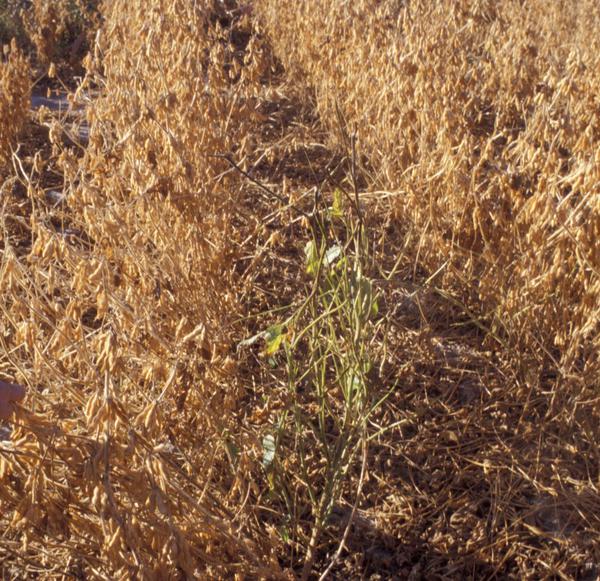Introduction
Tobacco ringspot virus (TRSV) has been identified in the United States, Canada, Australia, China, and Russia. However, distribution has not been well documented. TRSV is fairly common in North Carolina but yield losses in production fields are generally insignificant.
Pathogen
TRSV belongs to the subfamily Comovirinae and is a member of the genus Nepovirus. It has a wide host range including many field crops and weed species.
Symptoms
Plants that are infected early may show signs of stunting. Infection also causes flower and bud proliferation (Figure 1). Shepherd’s crooking of the terminal bud develops before other buds become necrotic and drop (Figure 2). Roots may be severely stunted, and the pith of stems show brown discoloration. Some infected plants develop ringspots on their leaves and become distorted. Pod development is poor in infected plants. Dark spots can be observed on the pods which may drop early or produce nonviable seeds. Stay-green of infected plants can be identified in an otherwise mature field (Figure 2 and Figure 3).
Disease Cycle
TRSV causes a systemic infection which generally moves from infected leaves to the roots. Rarely will it move from the roots to the leaves. TRSV can be transmitted by some arthropods, such as thrips and grasshoppers, as well as the dagger nematode. However, transmission efficiency for these vectors is low. This virus is more easily sap transmissible and is at greater risk of moving from young leaves than mature. Transmission of TRSV from one season to the next can also be caused by infected seed. Seed can become infected from a systemically infected plant and the virus can stay viable for years.
Management
Ensuring only high quality, certified seed is planted will help greatly to prevent infection of TRSV within the field. There are a few varieties with some known resistance that can be used if the field is more at risk. Avoiding fields with dagger nematodes can help prevent some transmission by vector.
Useful Resources
The NC State University Plant Disease and Insect Clinic provides diagnostics and control recommendations.
The NC State Extension Plant Pathology portal provides information on crop disease management.
The North Carolina Agricultural Chemicals Manual provides pesticide information for common diseases of North Carolina. The manual recommendations do not replace those described on the pesticide label, and the label must be followed.
Acknowledgments
This factsheet was prepared by the NC State University Field Crops and Tobacco Pathology Lab in 2020.
- Check out our Facebook and our Twitter!
Publication date: Sept. 10, 2020
N.C. Cooperative Extension prohibits discrimination and harassment regardless of age, color, disability, family and marital status, gender identity, national origin, political beliefs, race, religion, sex (including pregnancy), sexual orientation and veteran status.
NC Cooperative Extension prohíbe la discriminación por raza, color, nacionalidad, edad, sexo (incluyendo el embarazo), discapacidad, religión, orientación sexual, identidad de género, información genética, afiliación política, y estatus de veteran.
The use of brand names in this publication does not imply endorsement by NC State University or N.C. A&T State University of the products or services named nor discrimination against similar products or services not mentioned.
Recommendations for the use of agricultural chemicals are included in this publication as a convenience to the reader. The use of brand names and any mention or listing of commercial products or services in this publication does not imply endorsement by NC State University or N.C. A&T State University nor discrimination against similar products or services not mentioned. Individuals who use agricultural chemicals are responsible for ensuring that the intended use complies with current regulations and conforms to the product label. Be sure to obtain current information about usage regulations and examine a current product label before applying any chemical. For assistance, contact your local N.C. Cooperative Extension county center.
N.C. Cooperative Extension prohibits discrimination and harassment regardless of age, color, disability, family and marital status, gender identity, national origin, political beliefs, race, religion, sex (including pregnancy), sexual orientation and veteran status.



